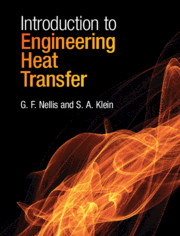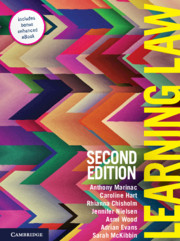Refine search
Actions for selected content:
36809 results in Cambridge Textbooks

Introduction to Engineering Heat Transfer
-
- Published online:
- 24 November 2020
- Print publication:
- 30 July 2020
-
- Textbook
- Export citation

Learning Law
-
- Published online:
- 19 November 2020
- Print publication:
- 07 October 2020
-
- Textbook
- Export citation
4 - Evaluation
- from Part I - Introduction and Overview
-
- Book:
- Essentials of Pattern Recognition
- Published online:
- 08 December 2020
- Print publication:
- 19 November 2020, pp 63-98
-
- Chapter
- Export citation
2 - Mathematical Background
- from Part I - Introduction and Overview
-
- Book:
- Essentials of Pattern Recognition
- Published online:
- 08 December 2020
- Print publication:
- 19 November 2020, pp 15-43
-
- Chapter
- Export citation
Contents
-
- Book:
- Essentials of Pattern Recognition
- Published online:
- 08 December 2020
- Print publication:
- 19 November 2020, pp v-viii
-
- Chapter
- Export citation
Index
-
- Book:
- Essentials of Pattern Recognition
- Published online:
- 08 December 2020
- Print publication:
- 19 November 2020, pp 379-384
-
- Chapter
- Export citation
12 - Hidden Markov Model
- from Part IV - Handling Diverse Data Formats
-
- Book:
- Essentials of Pattern Recognition
- Published online:
- 08 December 2020
- Print publication:
- 19 November 2020, pp 266-290
-
- Chapter
- Export citation
5 - Principal Component Analysis
- from Part II - Domain-Independent Feature Extraction
-
- Book:
- Essentials of Pattern Recognition
- Published online:
- 08 December 2020
- Print publication:
- 19 November 2020, pp 101-122
-
- Chapter
- Export citation
Part II - Domain-Independent Feature Extraction
-
- Book:
- Essentials of Pattern Recognition
- Published online:
- 08 December 2020
- Print publication:
- 19 November 2020, pp 99-100
-
- Chapter
- Export citation
7 - Valued-Edge ERGMs: The Generalized ERGM (GERGM)
- from Part II - The Family of Exponential Random Graph Models (Ergms)
-
- Book:
- Inferential Network Analysis
- Published online:
- 30 October 2020
- Print publication:
- 19 November 2020, pp 148-164
-
- Chapter
- Export citation
Acknowledgments
-
- Book:
- Inferential Network Analysis
- Published online:
- 30 October 2020
- Print publication:
- 19 November 2020, pp xxiii-xxiv
-
- Chapter
- Export citation
Frontmatter
-
- Book:
- Essentials of Pattern Recognition
- Published online:
- 08 December 2020
- Print publication:
- 19 November 2020, pp i-iv
-
- Chapter
- Export citation
Frontmatter
-
- Book:
- Inferential Network Analysis
- Published online:
- 30 October 2020
- Print publication:
- 19 November 2020, pp i-iv
-
- Chapter
- Export citation
11 - Sparse and Misaligned Data
- from Part IV - Handling Diverse Data Formats
-
- Book:
- Essentials of Pattern Recognition
- Published online:
- 08 December 2020
- Print publication:
- 19 November 2020, pp 245-265
-
- Chapter
- Export citation
1 - Promises and Pitfalls of Inferential Network Analysis
- from Part I - Dependence and Interdependence
-
- Book:
- Inferential Network Analysis
- Published online:
- 30 October 2020
- Print publication:
- 19 November 2020, pp 3-16
-
- Chapter
- Export citation
13 - The Normal Distribution
- from Part V - Advanced Topics
-
- Book:
- Essentials of Pattern Recognition
- Published online:
- 08 December 2020
- Print publication:
- 19 November 2020, pp 293-315
-
- Chapter
- Export citation
15 - Convolutional Neural Networks
- from Part V - Advanced Topics
-
- Book:
- Essentials of Pattern Recognition
- Published online:
- 08 December 2020
- Print publication:
- 19 November 2020, pp 333-364
-
- Chapter
- Export citation
6 - Fisher’s Linear Discriminant
- from Part II - Domain-Independent Feature Extraction
-
- Book:
- Essentials of Pattern Recognition
- Published online:
- 08 December 2020
- Print publication:
- 19 November 2020, pp 123-140
-
- Chapter
- Export citation
Preface
-
- Book:
- Inferential Network Analysis
- Published online:
- 30 October 2020
- Print publication:
- 19 November 2020, pp xix-xxii
-
- Chapter
- Export citation
List of Tables
-
- Book:
- Inferential Network Analysis
- Published online:
- 30 October 2020
- Print publication:
- 19 November 2020, pp xiii-xiii
-
- Chapter
- Export citation
